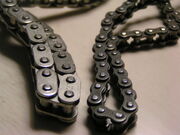A chain driven transmission is a simple piece of modern machinery that is designed to be stronger and more resilient to ground conditions that spindle and belt drive systems, but without proper maintenance, even a solid steel chain and gear system will quickly fail. With proper maintenance, a chain driven transmission will last the life of the vehicle and can provide a clean and quite drive mechanism.
This guide will not show you how to maintain your specific chain driven transmission, but it will give you guidelines that you should be able to apply to any chain driven mechanism.
Cleanliness = Godliness[]
The most important part of maintaining your chain is keeping the sand, dirt and water out of it. No amount of lubrication will protect a chain that has sand in its innards. In fact, too much lubrication can actually hold the contaminant to the chain and prolong the damage.
Cleaning a chain is simple but messy. It is important that you use a solvent that is capable of breaking down oils. Brake cleaners, engine cleaners, carb cleaners, rubbing alcohol, gasoline and even dish soap will break down any chain lubricant and free the dirt that forms a grinding paste inside the chain.
When cleaning is done right, the chain will be removed from the mechanism and allowed to soak in a solvent. Running an old tooth brush across the links can't hurt either. When cleaning is done quickly, it can be done while the the chain is still connected, but more solvent will need to be wasted in order to get the whole chain clean.
Lubricate where it matters[]
The only place that lubrication matters on a chain is in the internal bushings and between the links. It does not help the chain to have lubrication on the outside of the links. It also does not help to have lubrication on the sprockets. The best way to make sure your chain does not have excessive lubrication is to simply wipe it off. You can't get to where your chain actually needs lubrication with a paper towel.
If you lubricate only where necessary and use a good drying lubricant, you can almost eliminate splatter on your components and your pants.
Clean and lubricate often[]
It is obvious when a chain needs lubrication (rust, squeaking and chain stretch), but the goal is to make sure it never gets to that point. Dirty conditions require more frequent cleaning and lubrication. Clean conditions require less frequent cleaning and lubrication.
Good times to clean and re-lube:
- The scooter or kart has been stored away for more than a couple weeks.
- The chain is louder that usual
- The chain has a noticeable build-up of grim
- You have a gut feeling that cleaning is a good idea
- Your chain is starting to throw filth on you
If your chain is damaged, throw it away (and throw away your sprockets while you're at it)[]
As a chain ages and wears, it will make more noise and it won't fit the teeth of the sprockets as well anymore. This is a good time to throw out the old chain and gears and start over. It is much better to spend the time at home replacing the chain and sprockets than time at the track or on the trail swearing because you didn't. Once you skip a tooth, the transmission is done for. Luckily, #25 chains and sprockets (the most common size used) are cheap and easy to find.
Use a drying lubricant[]
Various teflon and wax lubricants are available that are specifically for use on exposed chains. These lubricants not only limit the amount of dirt and grime that sticks to your chain, but they also won't come off on you once they have dried. WD40 and other general purpose lubricants will not dry and generally inferior to drying lubricants anyway.
Keep your chain tight and check often[]
Your chain should be as tight as it can be without binding the drive mechanism. This keeps the load bearing parts of the chain grabbing onto the right parts of the gears and eliminates chain slap[1]. Some systems have a tensioner designed specifically to create a dynamic load on the chain to keep it tight. A good practice is to check the chain tension before every ride. Most often, adjustments will be unnecessary.
- ↑ a destructive jerking motion that a loose chain makes
